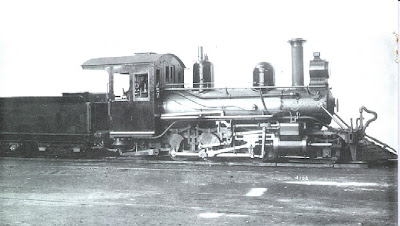Uma das mais curiosas e interessantes histórias de locomotivas é, sem dúvida, da locomotiva CMEF nº 26. Encomendada à Baldwin Locomotive Works e fabricada na Filadélfia em 1898, foi utilizada pela Companhia Mogiana de Estradas de Ferro no Ramal de Serra Negra, que ligava Amparo a esta cidade, em bitola estreita (0,60 m). É uma locomotiva com rodagem 2 - 6 - 0 (tipo Mogul), número de fabricação 18471, com peso de 41 toneladas. Ainda na CMEF, foi renumerada para nº 1 em 1914, e depois com a implantação do sistema de numeração em 1915, ganhou o nº 9. Na foto abaixo podemos ver a locomotiva nº 26 passando sobre um pontilhão em construção, tendo ao fundo casas de estilo típico da CMEF. Note o padrão de pintura da CMEF no início do século, com o nome da ferrovia por extenso escrito no tênder:
One of the most curious and interesting stories of locomotives is undoubtedly the locomotive CMEF 26. Commissioned to the Baldwin Locomotive Works in Philadelphia and built in 1898, was used by the Company Mogiana Railway in the Serra Negra Line, linking Amparo to this city, with narrow gauge (0,60 m). It is a locomotive with running 2 - 6 - 0 (Mogul type), number of manufacturing 18471, weighing 41 tons. Also in the CMEF, was renumbered to No. 1 in 1914, and then with the implementation of the numbering system in 1915, won the No. 9. In the photo below we can see the locomotive No. 26 passing over a bridge under construction in the background style homes typical of the CMEF. Note the pattern of painting CMEF at the beginning of the century, with the name of the railroad in words written in the tender:
Locomotiva nº 26 na época da Mogiana.
Em 1916, a então locomotiva nº 9 (ex-nº26) foi vendida para o Tramway da Cantareira, que também utilizava bitola estreita (0,60 m), e comprava locomotivas usadas de outras ferrovias, que alargavam sua bitola ou desativavam suas linhas. Manteve o número 9, e o Tramway da Cantareira chegou a ter duas locomotivas nº 9 ao mesmo tempo, sendo a outra ex-Ramal Férreo Santa Rita. Nessa foto podemos ver a locomotiva no tramway, repare no limpa-trilhos, típico da Mogiana:
In 1916, the then locomotive No. 9 (former 26) was sold to the Tramway Cantareira, who also used narrow gauge (0,60 m), and bought locomotives from other railroads, which widened its gauge or desativavam lines. Kept the number 9, and Tramway Cantareira came to have two locomotives No. 9 while the other ex-Santa Rita Rail Line. In this photo we can see the tramway locomotives, repair the rail sweeps, typical of Mogiana:
Locomotiva nº 26, no período Tramway da Cantareira.
Em 31 de março de 1942, o Tramway da Cantareira foi incorporado pela E.F. Sorocabana, que iniciou um plano de modernização, incluindo alargar a bitola de 0,60 m para 1,00 m. Por volta de 1950, a então locomotiva nº 9 foi vendida para a Usina Santa Teresa, perto de Goiana, Pernambuco. Junto com ela foi a locomotiva nº 27, igual a nº 26. Lá, foi rebitolada para 0,75 m e ganhou o número 11. Operou provavelmente até o fim da ferrovia, nos anos 1990. A partir daí, ficou abandonada na própia usina, até ser resgatada por um grupo e levada para o Reino Unido, na Brecon Mountain Railway, onde está sendo atualmente restaurada, sendo convertida para a bitola de 0,58 cm. Essa é a foto no site da ferrovia:
On March 31, 1942, the Cantareira Tramway was accired by the Sorocabana EF, which began a modernization plan, including extending the gauge of 0,60 m to 1,00 m. By 1950, the then locomotive No. 9 was sold to Santa Teresa Plant near Goiana, Pernambuco. Along with it was the locomotive No. 27, equal to 26. There was transformed to 0,75 gauge got the number 11. Operated probably by the end of the railroad in the 1990s. From there, it was abandoned in the plant, until rescued by a group and taken to the United Kingdom, Brecon Mountain Railway, which is currently being restored and converted to the gauge of 0,58 cm. This is the photo on the site of the railroad:
Restauração da locomotiva nº 26.
Esperamos que a nº 26 volte a operar em breve, para ajudar a contar um pouco mais da história das ferrovias no Brasil!
We hope that the No. 26 back to operate soon, to help tell a little of the history of railways in Brazil!



.jpg)
58 cm? Que companhia operava essa bitola, e onde ficava a linha?
ResponderExcluirÉ a bitola utilizada na Brecon Mountain Railway, que preserva um trecho da Brecon and Merthyr Railway, antiga ferrovia que tambpem utilzava 58 cm. Fica Merthyr Tydfil, País de Gales.
Excluir